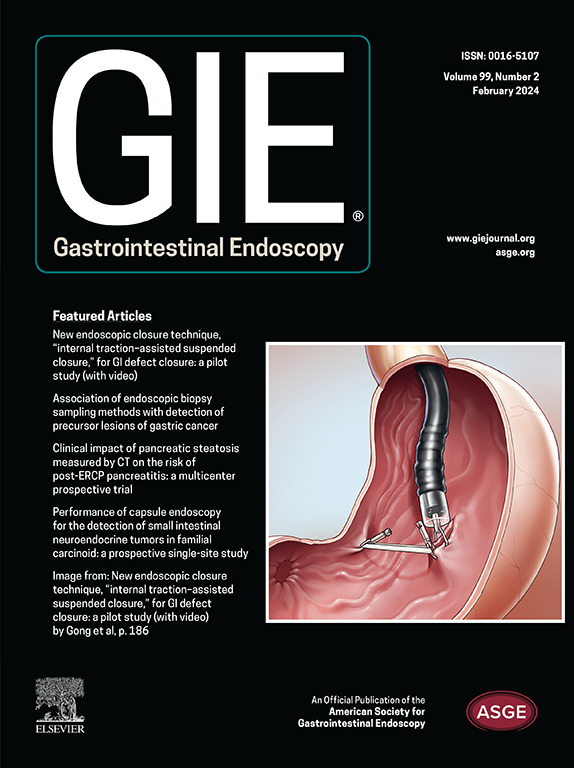内窥镜超声评估心房颤动导管消融术后的食管损伤。
IF 6.7
1区 医学
Q1 GASTROENTEROLOGY & HEPATOLOGY
引用次数: 0
摘要
背景和目的:心房颤动(房颤)消融是一种使用率越来越高的节律控制策略,它可能会损伤纵隔内的邻近结构,包括食管。寰食管瘘和食管心包瘘是威胁生命的并发症,被认为是由早期食管粘膜损伤(EI)发展而来。内镜超声(EUS)被认为是比胃肠造影(EGD)更优越的检查 EI 和深层结构损伤的方法。我们旨在评估 EUS 在对消融术后 EI 进行分类方面的安全性,并量化 EUS 检测到的病变及其与损伤严重程度和临床病程的相关性。采用堪萨斯城分类法(KCC)对 EI 进行分类(1 型、2a/b 型、3a/b 型):EUS 发现了胸腔积液(31.6%)、纵隔增生改变(22.2%)、纵隔淋巴结病(14.1%)、肺静脉改变(10.6%)和食管壁改变(7.7%)。胃食管造影显示,175 名(75%)患者无食道梗阻,59 名(25%)患者有食道梗阻。通过多变量逻辑回归对 2a/b 型 EI 患者和无 EI 患者进行了比较,结果显示,EUS 显示食管壁异常(OR 72.85 (95% CI 13.9-380.7))、女性(OR 3.97 (95% CI 1.3-12.3))和能量分娩次数(OR 1.01 (95% CI 1.003-1.03))与 2a 或 2b 型 EI 的存在相关。消融前使用 PPI 与 EI 风险降低无关:EUS可安全评估房颤消融术后的纵隔损伤,在评估意义不明的粘膜病变方面可能优于EGD,在全厚度损伤(肠血管瘘)的情况下可降低气体栓塞的风险。我们建议在心房颤动消融术后检查中首先采用 EUS 引导的方法,然后在安全的情况下再进行 EGD 检查。本文章由计算机程序翻译,如有差异,请以英文原文为准。
EUS for the evaluation of esophageal injury after catheter ablation for atrial fibrillation
Background and Aims
Atrial fibrillation (AF) ablation is an increasingly used rhythm control strategy that can damage adjacent structures in the mediastinum including the esophagus. Atrioesophageal fistulas and esophagopericardial fistulas are life-threatening adverse events that are believed to progress from early esophageal mucosal injury (EI). EUS has been proposed as a superior method to EGD to survey EI and damage to deeper structures. We evaluated the safety of EUS in categorizing postablation EI and quantified EUS-detected lesions and their correlation with injury severity and clinical course.
Methods
We retrospectively reviewed 234 consecutive patients between 2006 and 2020 who underwent AF ablation followed by EUS for the purpose of EI screening. The Kansas City classification was used to classify EI (type 1, type 2a/b, or type 3a/b).
Results
EUS identified pleural effusions in 31.6% of patients, mediastinal adventitia changes in 22.2%, mediastinal lymphadenopathy in 14.1%, pulmonary vein changes in 10.6%, and esophageal wall changes in 7.7%. EGD revealed 175 patients (75%) without and 59 (25%) with EI. Patients with type 2a/b EI and no EI were compared with multivariate logistic regression, and the presence of esophageal wall abnormality on EUS (odds ratio [OR], 72.85; 95% confidence interval [CI], 13.9-380.7), female sex (OR, 3.97; 95% CI 1.3-12.3), and number of energy deliveries (OR, 1.01; 95% CI, 1.003-1.03) were associated with EI type 2a or 2b. Preablation use of proton pump inhibitors was not associated with a decreased risk of EI.
Conclusions
EUS safely assesses mediastinal damage after ablation for AF and may excel over EGD in evaluating mucosal lesions of uncertain significance, with a reduced risk of gas embolization in the setting of a full-thickness injury (enterovascular fistula). We propose an EUS-first guided approach to post-AF ablation examination, followed by EGD if it is safe to do so.
求助全文
通过发布文献求助,成功后即可免费获取论文全文。
去求助
来源期刊

Gastrointestinal endoscopy
医学-胃肠肝病学
CiteScore
10.30
自引率
7.80%
发文量
1441
审稿时长
38 days
期刊介绍:
Gastrointestinal Endoscopy is a journal publishing original, peer-reviewed articles on endoscopic procedures for studying, diagnosing, and treating digestive diseases. It covers outcomes research, prospective studies, and controlled trials of new endoscopic instruments and treatment methods. The online features include full-text articles, video and audio clips, and MEDLINE links. The journal serves as an international forum for the latest developments in the specialty, offering challenging reports from authorities worldwide. It also publishes abstracts of significant articles from other clinical publications, accompanied by expert commentaries.
 求助内容:
求助内容: 应助结果提醒方式:
应助结果提醒方式:


